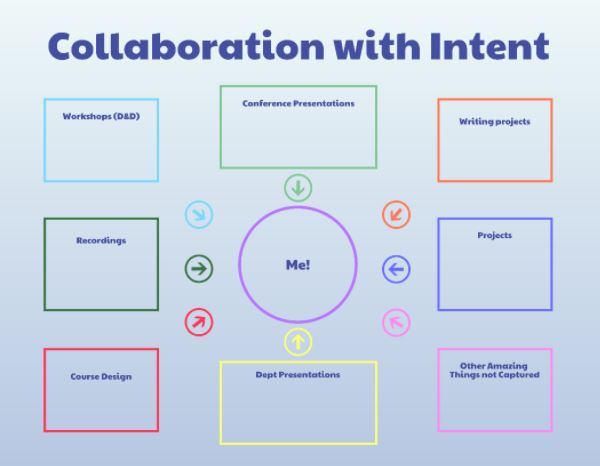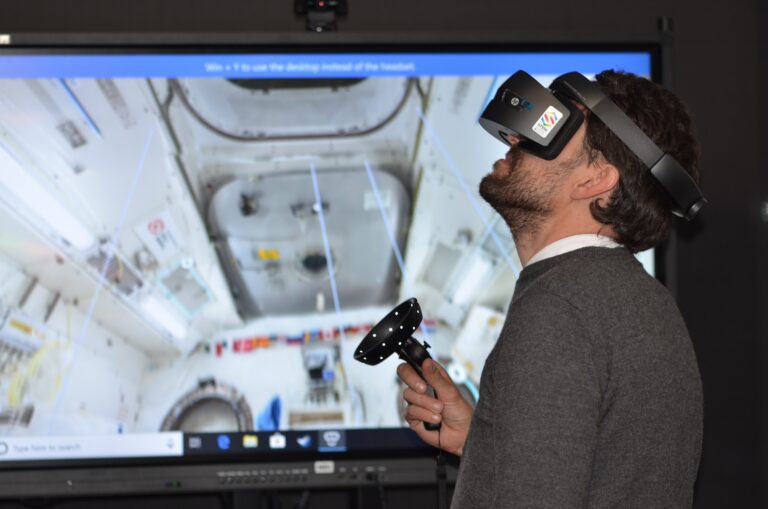A Suite of Checklists to Develop Blended Courses @ KPU
As we gradually return to the classroom after almost two years of online teaching, you may be thinking about your teaching practice, perhaps creative ways to combine both in-person and online learning. If you are interested to develop a course in a blended format, and not very sure where to start, I hope to pique your interest on this topic. I had the privilege in my role as an Educational Consultant to develop a suite of checklists to support faculty with the development of blended courses. In this blog, I wish to lay out a framework of these checklists. Before we begin, lets explore what blended learning means.
What is Blended Learning?
KPU is in the final stages of developing a working definition of Blended learning that aligns to the Ministry’s definition, the literature and the operational needs of registration, scheduling and transparency for students. At this time, yet to be finalized, blended learning is an experience that combines in-person and online delivery to best suit course learning outcomes, with between 25% and 75% of instructional weeks (4-10 weeks in a 13-week semester) spent online. The online portion of the course, can be scheduled and blended asynchronously or synchronously. Teaching in a blended format brings the best of both in-person and online learning experiences for instructors and students. However, a course designed to be delivered in-person or a fully online environment does not directly translate into a blended space. Teaching in a blended environment requires careful planning, integration, and blending between different learning spaces as well as delivery modalities. The proposed suite of checklists discussed in this blog, is designed to scaffold faculty through the development and delivery of blended courses.
The OLC Scorecard for Blended Programs
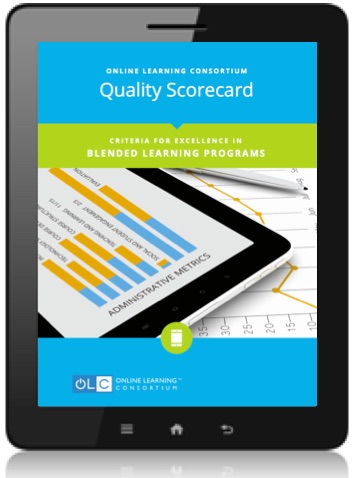
The creation of these suite of checklists was inspired by the scorecard developed by the Online Learning Consortium (OLC) that quantifies elements of quality in blended programs. You can download the OLC quality scorecard for blended programs via https://onlinelearningconsortium.org/consult/olc-quality-scorecard-blended-learning-programs/ The scorecard is developed around seven themes, that capture quality standards through a list of statements. A total of 270 points are distributed using a 4-point scale across these statements. The final score can then be compared with a rubric that highlights the overall quality of a blended program. A handbook is available for purchase (see the above link) with instructions to administer the scorecard.
While the OLC quality scorecard for blended programs is an excellent resource, quality standards in some themes to measure outcomes are beyond the control of the instructor. Although most quality criteria in the scorecard can guide blended course design, the primary use of the scorecard is to measure the quality of existing courses, or new courses after they are developed. Further, the number of quality standard statements in the scorecard may overwhelm a novice designer.
Blended Course Development Checklist Suite
The proposed blended course development checklist suite takes a different approach. These checklists scaffold faculty with prompts as they design, plan, and facilitate the delivery of blended courses. All prompts to guide this process are within the full control of concerned faculty. This suite of checklists is developed in three phases.
PHASE ONE : The current phase includes the creation of a framework with checklists that includes design principles, planning and the facilitation of blended course delivery. The framework, key themes that will be converted into detailed checklist probes in the next phase are illustrated in the visual below.
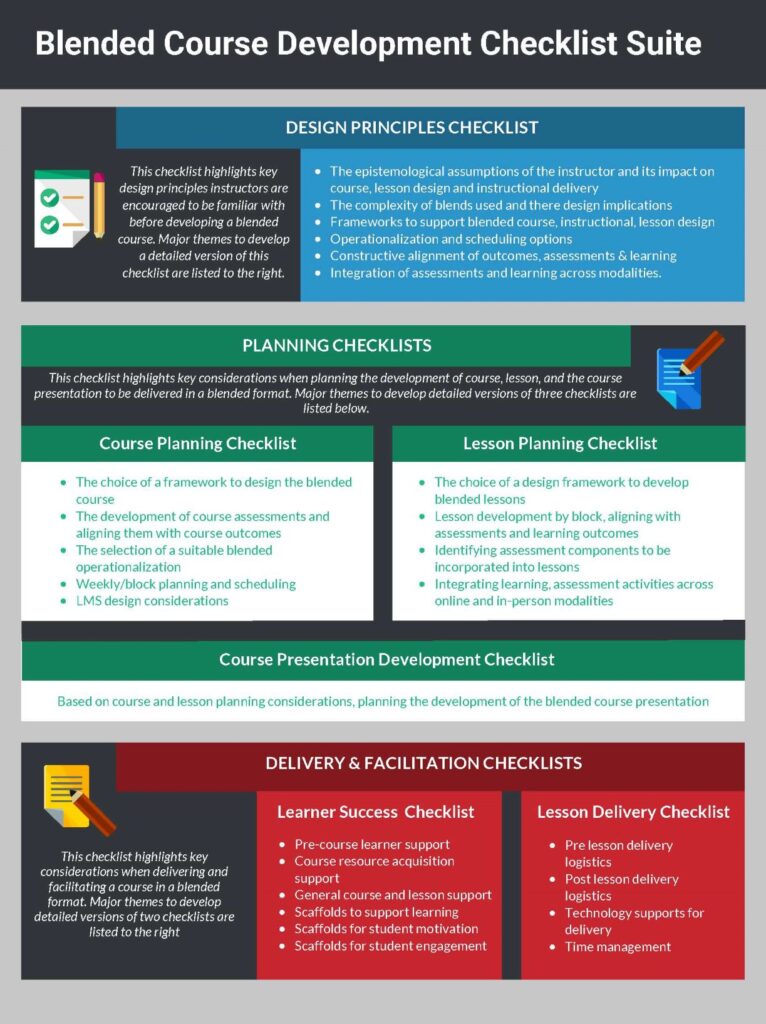
Let’s dive into more detail and explore these checklists and their themes.
Design Principles Checklist

Core design principles, faculty are encouraged to be familiar with can be found in this checklist. If you are interested to learn about these principles, consider registering for the Pedagogy and Practice of Blended Delivery workshop series offered by TLC. The first block of this workshop will introduce participants to the epistemological assumptions, complexity of blends, frameworks to develop blended courses, lessons, and instruction. Further, three possible operationalizations for scheduling blended courses, the principle of constructive alignment and best practices to integrate activities between modalities are discussed. These foundational principles are key for instructors to develop a pedagogically sound blended course.
Planning Checklists
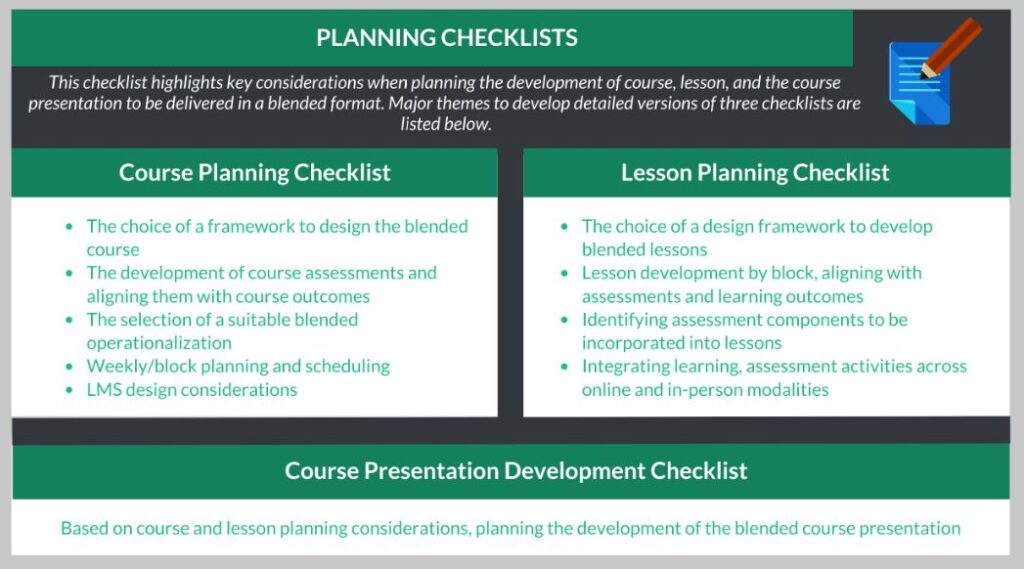
Three separate checklists for course planning, lesson planning and course presentation development are included in this section. Key themes of these checklists are highlighted in the above image.
Guidance to select a suitable course design framework, the process to align course assessments with outcomes, the selection of a suitable operationalization, insights to develop weekly block plans with online and in-person rotations, and the development of the Moodle LMS, is discussed in the course planning checklist.
The lesson planning checklist includes specific guidance to select blended lesson design frameworks, lesson and assessment development by block, alignment, and integration of in-person and online activities.
The final check list will highlight considerations to develop the course presentation for blended courses.
Delivery and Facilitation Checklists
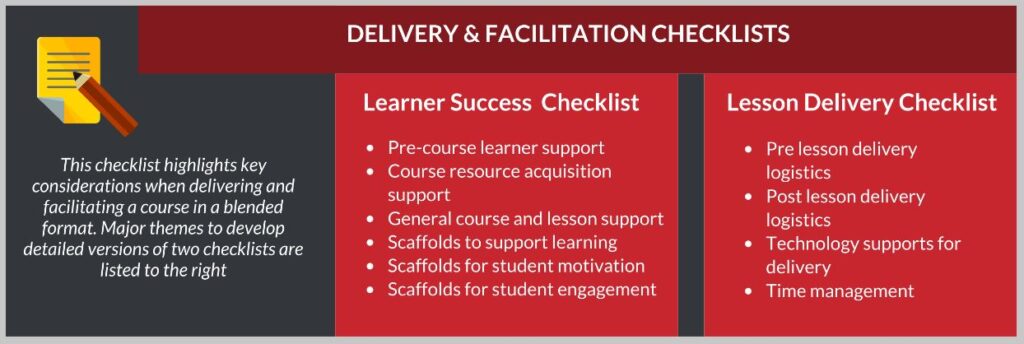
Two separate checklists (see image above) with guidance for faculty to support students and the delivery of lessons are provided here. Students need to be adequately supported, engaged, and motivated to interact with course content, with their peers and the instructor throughout the course. The multi modality nature of the delivery tools makes this task challenging if not thoughtfully scaffolded. The learner success checklist addresses these supports. The lesson delivery checklist provides key prompts to consider when managing the logistics of lesson delivery.
PHASE TWO: Key themes in the planning, delivery and facilitation sections of the framework will be developed into checklist items in this phase. These checklists will be presented and discussed in the second and the third block of the Pedagogy and Practice of Blended Delivery workshop series.
For those faculty who may not get a chance to attend these workshop series, the full checklist suite will be released via the Teaching and Learning Freshdesk resource-base later this summer.
PHASE THREE: A scorecard format of these checklist prompts can measure the quality of fully developed blended courses. Faculty who teach blended courses can self-audit their current courses and identify areas to be continued, amended, dropped, and/or added. These prompts will be converted into a scorecard format in the fall of 2022.
At the end of all three phases, faculty will have a suite of checklists to develop pedagogically sound courses and a scorecard to audit the quality of their current blended courses.
The Pedagogy and Practice of Peer Review Workshop Series
This workshop is developed using a flipped blended model and delivered in three learning blocks. Each block includes several guided online asynchronous learning modules followed by a synchronous online session. During a specified period, participants will complete several learning activities related to the design of blended courses. During the synchronous sessions, asynchronous activities completed by participants will be discussed and reviewed.
Block one will introduce participants to the foundational principles of blended course design and delivery. Contents of this block was introduced earlier in the design checklist section.
Block two will assist participants to design a pedagogically sound blended course. Here, participants will develop a 13-week full semester block plan for a course to be delivered in a blended format.
In block three, participants will develop a blended lesson plan for one of the 13-week semester blocks developed earlier. This will include the development, constructive alignment of learning and assessments with course outcomes, and selecting appropriate media and technology tools.
Further, participants will develop a full course presentation to be delivered in a blended format.
The course facilitator will be available to assist participants as they complete the online asynchronous modules.
The first of these Pedagogy and Practice of Blended Delivery workshop series is currently open for registrations (Register here). It is scheduled to start on April 22, and end on July 22, 2022. If you miss this workshop, you can take it in an upcoming semester.
Stay tuned for exciting developments on blended learning and delivery at KPU.

Nishan Perera
Nishan considers himself as a creative professional educator with a passion for teaching and research in the fields of Business and Marketing. He has over twenty-five years of consolidated experience in teaching, curriculum development, academic administration, training, entrepreneurial and commercial business management. He loves to use technology for teaching and has a deep appreciation in integrating technology with pedagogy to enhance student learning. Nishan provides consultations to faculty on curriculum development with an emphasis on delivering courses in a blended and an online format.

